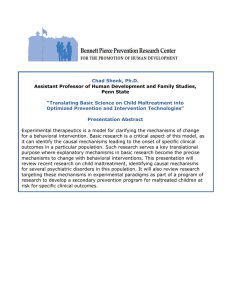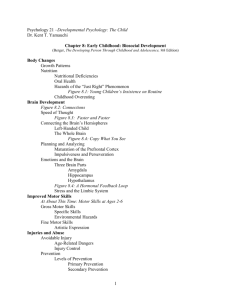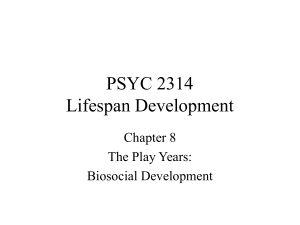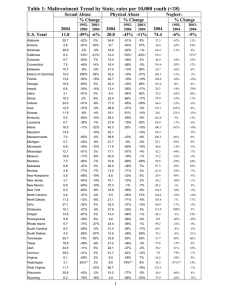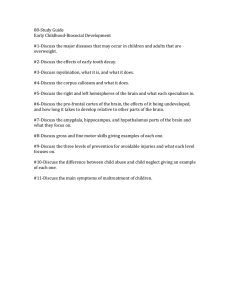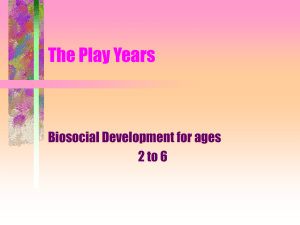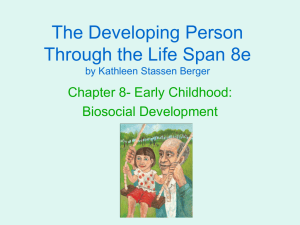Building Support for the Primary Prevention of Child Maltreatment
advertisement
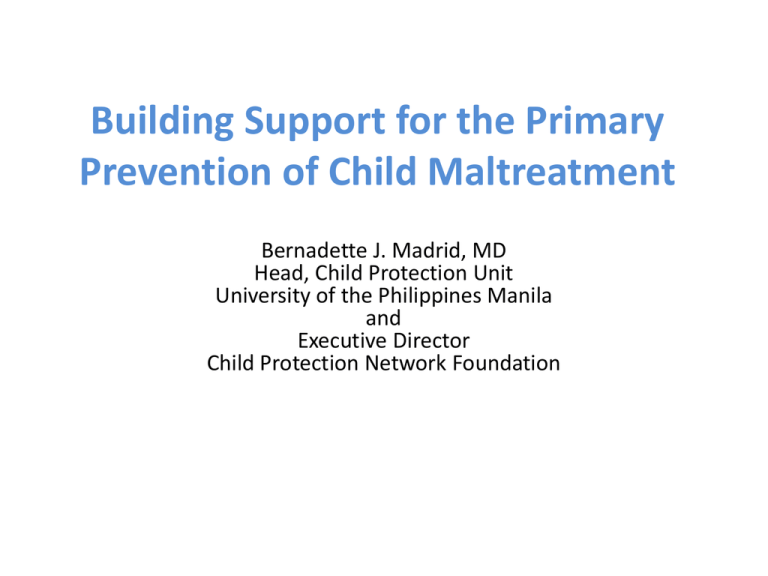
Building Support for the Primary Prevention of Child Maltreatment Bernadette J. Madrid, MD Head, Child Protection Unit University of the Philippines Manila and Executive Director Child Protection Network Foundation PHILIPPINE SITUATION • Population : more than 92 million • Annual population growth rate: 2.04 • Poverty incidence worsened: 24.4% (2003) to 26.7% (2006) • High income inequality compared to Asian neighbors • Off-track in meeting MDG targets for Poverty Education Maternal health Malnutrition PHILIPPINE SITUATION • Low spending on social protection programs 0.3% of GDP in 2007 to 0.8% in 2008 • Lack of policy & institutional coordination • Social protection has a narrow base of beneficiaries • Social protection programs are: numerous; with limited reach; inadequately funded; short-lived • High leakage rate Philippine National Budget Year 2008 • National budget: 2008 Education = 13.8% Social Welfare = 5.64% Health = 1.6% • The budget cannot cover for basic services Source: E-Net Philippines, 2008. Traditional Political Support • In the Philippines, education has the highest political support and still it is not enough. There are just so many deficiencies in education. • CSR of corporations and individual donors usually support education. • The Philippines is just preparing for public kindergarten and after ten years: K12. Support for Primary Prevention of Child Maltreatment • “It is unlikely that political leaders will support the level of resources needed to develop high-quality programs targeted at preventing child maltreatment , which will be seen as affecting only a small proportion of children. “ Michael Wald (2009) Preventing Maltreatment or Promoting Positive Dev’tWhere should a community focus its resources? In Dodge & Coleman (Ed), Preventing Child Maltreatment Community Approaches. New York: The Guilford Press. Stages of Building Support for the Primary Prevention of Child Maltreatment • First National Meeting on Preventing Child Maltreatment 2007 2008 2009 • Research: Adverse Childhood Experiences (ACE) and Health Risk Behaviors Among Adults in a Developing Country Setting • Research: Child Maltreatment Prevention the Philippines: A country situation analysis CPU Network & Department of Health in partnership with WHO Stages of Building Support for the Primary Prevention of Child Maltreatment 2010 2011 2012 • National Multi- sectoral Consultative Meeting on Strengthening Responses to Child Maltreatment / Violence against Children in the Philippines • National Prevalence Study on Violence Against Children • Triple P Positive Parenting Program Conference • Completion of the Prevalence Study • Start of the Triple P pilot project CPU Network & Council for the Welfare of Children in partnership with WHO Objectives of the First National Meeting on Preventing Child Maltreatment 1. Recognize that child abuse and neglect is an important problem in the Philippines today and has life-long impact on risk behaviors and chronic disease. 2. Appreciate that child abuse and neglect is preventable and that there are prevention programs that have been shown to work. Objectives of the First National Meeting on Preventing Child Maltreatment 3. Understand the problems that have prevented programs from being adapted in a wider scale. 4. Take the steps necessary to come up with a national plan on the prevention of child abuse and neglect. PARTICIPANTS of the First National Meeting Leaders and policy makers • Health • Social Welfare • Education • Academe • Professional Societies • International Org • • • • • • Congress Local government Legal Labor Media NGO’s NEXT STEPS recommended by the First National Meeting: • Creation/Expansion of Inter-Agency Committee? • National Plan for Primary Prevention of Child Maltreatment (to include framework for coordination) • Integration of Prevention of Child Maltreatment in public health programs • Data Management • Evaluation Tool to measure effectiveness of the interventions What was obvious • The Department of Health did not really want to lead the process. • Child Maltreatment is seen as a social problem and as such the leadership should naturally be the Department of Social Welfare and Development. Long Term Effects of Child Maltreatment • Adverse Childhood Experiences (ACEs) still have profound effect 50 years later • Transformed from psychosocial experience into organic disease, social malfunction and mental illness • ACEs are the main determinant of the health & social well-being of the nation. Results of the Metro Manila ACE Study Those who were sexually abused are: • 12 times more likely to engage in early sex; • 9 times more likely to have early pregnancy; • 5 times more likely to commit suicide. Ramiro, Madrid, Brown 2010 Child Abuse & Neglect 34: 842-845 Results of the Metro Manila ACE Study Individuals who felt that they were not loved during childhood are: • Twice as likely to smoke, use illicit drugs, have early sex and multiple sex partners • 5 times more likely to commit suicide. Ramiro, Madrid, Brown 2010 Child Abuse & Neglect 34: 842-845 Strong graded response between number of ACEs & poor health • Bronchitis/ emphysema • Asthma • Ischemic Heart Disease • Hypertension • Tuberculosis • • • • Skin problems UTI Liver problems GI problems- ulcers, constipation, indigestion • Depression Ramiro, Madrid, Brown 2010 Child Abuse & Neglect 34: 842-845 CHILD MALTREATMENT PREVENTION IN THE PHILIPPINES: A COUNTRY SITUATION ANALYSIS Bernadette J. Madrid, MD Laurie Ramiro, PH.D. John Go, MD Juanita Basilio, MD Supported by WHO, 2009 OBJECTIVES OF THE STUDY 1. To do a national situation analysis on child maltreatment prevention using secondary data and stakeholder interviews; 2. To assess how municipalities and barangays implement their child maltreatment primary prevention program. Study Settings • The study had a national and local coverage. • Three barangays in the city of Manila, 3 in Quezon City and 3 in rural San Juan, Batangas. METHODOLOGY Aspects of prevention programs targeted: 1. Prevention readiness refers to the knowledge, attitudes and attributions that policy makers and opinion leaders have about child maltreatment. Qualitatively assessed through structured conversations with key individuals and content analysis of official documents and reports. Quantitatively assessed using Community Readiness Model of Plested, et al. (2006). 2. Prevention resources are what actually exist by way of information and information systems; and resources of government and nongovernment agencies specifically tasked to prevent child maltreatment Community Readiness Model (Plested, Edwards, & Jumper-Thurman, 2006) A model for community change that integrates a community’s culture, resources and level of readiness to more effectively address an issue. Allows communities to define issues and strategies in their own context Builds cooperation among organizations and individuals Increases community capacity for prevention and intervention Encourages and enhances community efforts 9. High Level of Community Ownership STAGES OF COMMUNITY READINESS 8. Confirmation / Expansion 7. Stabilization 6. Initiation 5. Preparation 4. Preplanning 3. Vague Awareness 2. Denial / Resistance 1. No Awareness Child Maltreatment Prevention in the Philippines: A country situation analysis Intervention level State & society Developmental stage < 3 years 3-11 years 12-17 years Adulthood Implementing legal reform and human rights •Translating the CRC into national laws Very many laws: PD 603- The Child & Youth Welfare Code RA 7610 – Child Protection RA 7658 – Prohibiting child labor RA 9231 – Worst form of child labor RA 9262 - Against Domestic Violence RA 9208 - Anti Trafficking RA 9344 – Juvenile Justice Law RA 9775 – Anti child pornography Very many policies, local government codes Child 21 (2025) –child sensitive & child friendly society serves as the road map National Plan of Action for Children- 5- year frame MDGs (Madrid, Ramiro, et. al. 2009) Child Maltreatment Prevention in the Philippines: A country situation analysis Intervention level State & society Developmental stage < 3 years 3-11 years 12-17 years Adulthood Implementing legal reform and human rights •Most laws are unfunded or the funds is “ embedded” in a department’s budget •Too many implementing bodies specified in the mandates •It is not clear how it will be implemented in the local level •There is no sanction if it is not implemented •Since it is unfunded and no personnel, it is made to fit into services already in place (Madrid, Ramiro, et. al. 2009) Child Maltreatment Prevention in the Philippines: A country situation analysis Intervention level Developmental stage < 3 years 3-11 years 12-17 years Adulthood Introducing beneficial social and economic policies •Providing early childhood education and care Early Childhood Care and Development Act State & society •Ensuring universal primary and secondary education Philippine National Plan of Action to Achieve Education for All by year 2015 •Investing in good social protection systems Achieving Universal Health Care for All Filipinos embodied in DOH Administrative Order No. 2010-0036 (Madrid, Ramiro, et. al. 2009) Child Maltreatment Prevention in the Philippines: A country situation analysis Intervention level Developmental stage < 3 years 3-11 years 12-17 years Changing cultural and social norms •Pending bill: Anti-corporal punishment State & society Reducing economic inequalities •Tackling poverty Conditional Cash Transfer (3 Ps) Environmental risk factor reduction •No Smoking in public places •Clean Air Act (Madrid, Ramiro, et. al. 2009) Adulthood Child Maltreatment Prevention in the Philippines: A country situation analysis Intervention level Developmental stage < 3 years 3-11 years parenting programs e.g. PES 12-17 years Relationships Home visitation programs; Parenting Individual Increasing access Life skills education to child care UNICEF Child Friendly School Model services, social Personal Safety Lessons in Schools support (Madrid, Ramiro, et. al. 2009) Parenting programs e.g. PES Programs for the prevention of child maltreatment • Most of the programs were established not specifically to prevent child maltreatment but to improve the health, education and social status of the child. • The implementation is based on the “limited good principle”. • No evaluation of program effectiveness (A.I.D.S.) • Provisions for children are scattered across various departments, without any formal connections or consistent policy or practice. • NGO’s and international organizations fill in the gaps. Child Maltreatment Prevention in the Philippines: A country situation analysis • Very few leaders except for those directly involved e.g. social welfare, health, know about the different laws involving children. • There is really no separate budget for children. • No updated data on child maltreatment. (Madrid, Ramiro, et. al. 2009) Level of Prevention Readiness City/Municipality Stage of Community Readiness 1. Quezon City Stage 5 (Preparation Stage) 2. Manila Stage 4 Post workshop Stage 7 (Stabilization Stage) San Juan, Batangas Stage 3 Post workshop Stage 2 (Denial Stage) 3. (Preplanning Stage) (Vague Awareness Stage) Common Next Steps for the 3 areas involved in the study 1. Baseline survey on child maltreatment prevalence Quezon city – all forms of CAN San Juan – corporal punishment 2. Orientation and training of leaders of the community 3. Information dissemination to community members about child abuse and neglect and the programs of the city. 4. Plan for evaluation Way to Go • Formation of a coalition of government agencies and NGO’s that will steer the country’s direction towards prevention of child maltreatment • National Prevalence Study on Child Maltreatment • Invest on a primary prevention program that is population-based; has been shown to work and can generate political support: Parenting Program National Network to End Violence Against Children Government Agencies • • • • • • • Council for the Welfare of Children Department of Social Welfare & Development Department of Education Department of Health Department of Labor and Employment Department of Interior and Local government Philippine National Police Non-government Agencies • Child Protection Network • Parenting Foundation of the Philippines • Open Heart Foundation, Inc. • Lunduyan Foundation, Inc. • Asia-Pacific Regional NGO Representative to Follow-Up VAC Recommendations • National Council for Social Development • PLAN International, Inc. • Save the Children • ECPAT • UNICEF Manila
